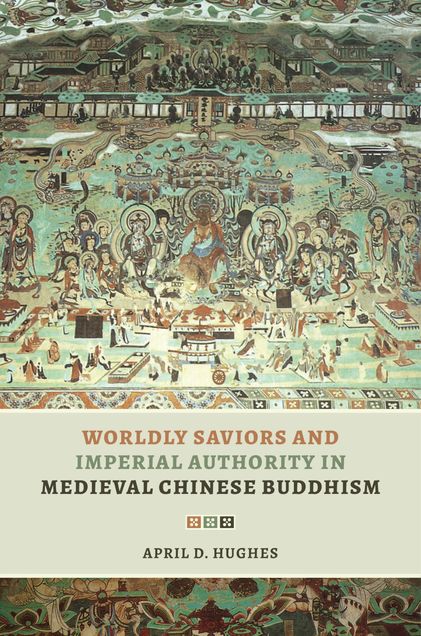New book by April Hughes (REL), Worldly Saviors and Imperial Authority in Medieval Chinese Buddhism
We are pleased to draw your attention to Prof. April Hughes’ new book, Worldly Saviors and Imperial Authority in Medieval Chinese Buddhism, published this month by the University of Hawaii Press. Congratulations April!
About the Book: (from the publisher)
 Although scholars have long assumed that early Chinese political authority was rooted in Confucianism, rulership in the medieval period was not bound by a single dominant tradition. To acquire power, emperors deployed objects and figures derived from a range of traditions imbued with religious and political significance. Author April D. Hughes demonstrates how dynastic founders like Wu Zhao (Wu Zetian, r. 690–705), the only woman to rule China under her own name, and Yang Jian (Emperor Wen, r. 581–604), the first ruler of the Sui dynasty, closely identified with Buddhist worldly saviors and Wheel-Turning Kings to legitimate their rule. During periods of upheaval caused by the decline of the Dharma, worldly saviors arrived on earth to quell chaos and to rule and liberate their subjects simultaneously. By incorporating these figures into the imperial system, sovereigns were able to depict themselves both as monarchs and as Buddhas or Bodhisattvas in uncertain times.
Although scholars have long assumed that early Chinese political authority was rooted in Confucianism, rulership in the medieval period was not bound by a single dominant tradition. To acquire power, emperors deployed objects and figures derived from a range of traditions imbued with religious and political significance. Author April D. Hughes demonstrates how dynastic founders like Wu Zhao (Wu Zetian, r. 690–705), the only woman to rule China under her own name, and Yang Jian (Emperor Wen, r. 581–604), the first ruler of the Sui dynasty, closely identified with Buddhist worldly saviors and Wheel-Turning Kings to legitimate their rule. During periods of upheaval caused by the decline of the Dharma, worldly saviors arrived on earth to quell chaos and to rule and liberate their subjects simultaneously. By incorporating these figures into the imperial system, sovereigns were able to depict themselves both as monarchs and as Buddhas or Bodhisattvas in uncertain times.
In this inventive and original work, Hughes traces worldly saviors—in particular Maitreya Buddha and Prince Moonlight—as they appeared in apocalyptic scriptures from Dunhuang, claims to the throne made by various rebel leaders, and textual interpretations and assertions by Yang Jian and Wu Zhao. Yang Jian associated himself with Prince Moonlight and took on the persona of a Wheel-Turning King whose offerings to the Buddha were not flowers and incense but weapons of war to reunite a long-fragmented empire and revitalize the Dharma. Wu Zhao was associated with several different worldly savior figures. In addition, she saw herself as the incarnation of a Wheel-Turning King for whom it was said the Seven Treasures manifested as material representations of his right to rule. Wu Zhao duly had the Seven Treasures created and put on display whenever she held audiences at court.
The worldly savior figure allowed rulers to inhabit the highest role in the religious realm along with the supreme role in the political sphere. This incorporation transformed notions of Chinese imperial sovereignty, and associating rulers with a Buddha or Bodhisattva continued long after the close of the medieval period.
About the Author:
April D. Hughes received her Ph.D. in Religion fromPrinceton University in 2014.
 She completed M.A. degrees in East Asian Studies at the University of California, Berkeley and the University of California, Los Angeles. Her research situates medieval Chinese religion within broader cultural and social contexts. She is especially interested in medieval Chinese Buddhist manuscripts and mural paintings discovered at Dunhuang (northwest China). Her current book project is entitled “Personifying the Buddha: Politics, Gender, and Religion in Medieval China.” Over and against the assumption that political authority was argued chiefly in Confucian terms, the book investigates the different symbol systems (Confucian, Buddhist, and Daoist) that emperors employed to validate their reigns. Specifically, the book highlights the centrality of Buddhism to Chinese notions of kingship, since both emperors and rebels sometimes solidified claims to the imperial throne by declaring themselves Buddhas incarnate, descended to earth in order to rule and revive Buddhist Teachings.
She completed M.A. degrees in East Asian Studies at the University of California, Berkeley and the University of California, Los Angeles. Her research situates medieval Chinese religion within broader cultural and social contexts. She is especially interested in medieval Chinese Buddhist manuscripts and mural paintings discovered at Dunhuang (northwest China). Her current book project is entitled “Personifying the Buddha: Politics, Gender, and Religion in Medieval China.” Over and against the assumption that political authority was argued chiefly in Confucian terms, the book investigates the different symbol systems (Confucian, Buddhist, and Daoist) that emperors employed to validate their reigns. Specifically, the book highlights the centrality of Buddhism to Chinese notions of kingship, since both emperors and rebels sometimes solidified claims to the imperial throne by declaring themselves Buddhas incarnate, descended to earth in order to rule and revive Buddhist Teachings.
“The importance of apocalyptic thought in medieval China has long been downplayed in Anglophone scholarship, so it is a great pleasure to have at last a book based firmly on the key surviving sources to redress this imbalance. April Hughes’ work is the first study to pull all of the materials together and put them and the political regimes and rebel movements that took cognizance of such beliefs in a helpful chronological sequence. It is original, sound, and important.”
—T. H. Barrett, SOAS, University of London
Worldly Saviors and Imperial Authority in Medieval Chinese Buddhism